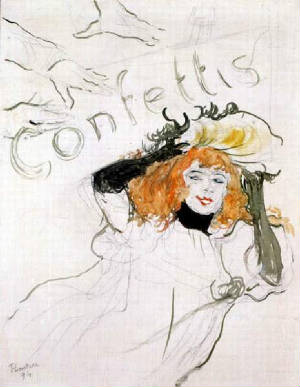|
Visit Burlesque Ireland
From Wikipedia, the free encyclopedia
(Redirected from Cabarets) Cabaret is a form of entertainment featuring comedy, song, dance, and theatre, distinguished mainly by the performance venue — a restaurant or nightclub with a stage for performances and the audience sitting around the tables (often dining or drinking) watching the performance.
The venue itself can also be called a "cabaret." The turn of the 20th century introduced a revolutionized cabaret culture.
Performers included Josephine Baker and Brazilian drag performer João Francisco dos Santos (aka Madame Satã), both of whom were dark-skinned people of mixed ancestry. Cabaret performances could range from political satire to light entertainment, each being introduced by a master of ceremonies, or MC.
The term is a French word for the taprooms or cafés, where this form of entertainment was born, as a more artistic type of café-chantant. It is derived from Middle Dutch cabret, through Old North French camberette, from Late Latin camera.
It essentially means "small room."
Cabaret also refers to a Mediterranean style brothel — a bar with tables and women who mingle with and entertain
the clientele. Traditionally these establishments can also feature some form of stage entertainment: often singers & dancers
— the bawdiness of which vary with the quality of the establishment. It is the classier, more sophisticated cabaret
which eventually engendered the type of establishment and art-form which is the subject of the remainder of this article.
French cabaret
The first cabaret was opened in 1881 in Montmartre, Paris; Rodolphe Salís' "cabaret artistique." Shortly after it was founded, it was renamed Le Chat Noir (The Black Cat). It became a locale in which up-and-coming cabaret artists could try their new acts in front of their peers
before they were acted in front of an audience. The place was a great success, visited by important people of that time such
as Alphonse Allais, Jean Richepin, Aristide Bruant, and people from all walks of life: women of high society, tourists, bankers, doctors, journalists, etc. The Chat Noir
was a place where they could get away from work. In 1887, the cabaret was closed due to the bad economic situation which made amusements of this kind seem vulgar.
The Moulin Rouge, built in 1889 in the red-light district of Pigalle near Montmartre, is famous for the large red imitation windmill on its roof. Notable performers at the Moulin Rouge included
La Goulue, Yvette Guilbert, Jane Avril, Mistinguett, and Le Pétomane. Henri de Toulouse-Lautrec painted numerous pictures and scenes of night life there.
The Folies-Bergère continued to attract a large number of people until the start of the 20th century, even though
it was more expensive than other cabarets. People felt comfortable at the cabaret: they did not have to take off their hat,
could talk, eat, and smoke when they wanted to, etc. They did not have to stick to the usual rules of society.
At the Folies-Bergère, as in many cafés-concerts, there were a variety of acts: singers, dancers, jugglers,
clowns, and sensations such as the Birmane family, all of whom had beards. Audiences were attracted by the danger of the circus
acts (sometimes tamers were killed by their lions), but what happened on stage was not the only entertainment. Often patrons
watched others, strolled around, and met friends or prostitutes. At the start of the 20th century, as war approached, prices
rose further and the cabaret became a place for the rich.
|
 |
|
|
|
 |
|
***
****


| Les Avant Garde |

|
| WebSite - Network |
| Cultural Zionism |

|
| WebSite |
Destination Cities :
***
Alexandria Night Life ( NightLife ), RMC
The City of Miami and Miami Beach Night Life ( NightLife ), RMC
***
|
 |
|
|
|
|

